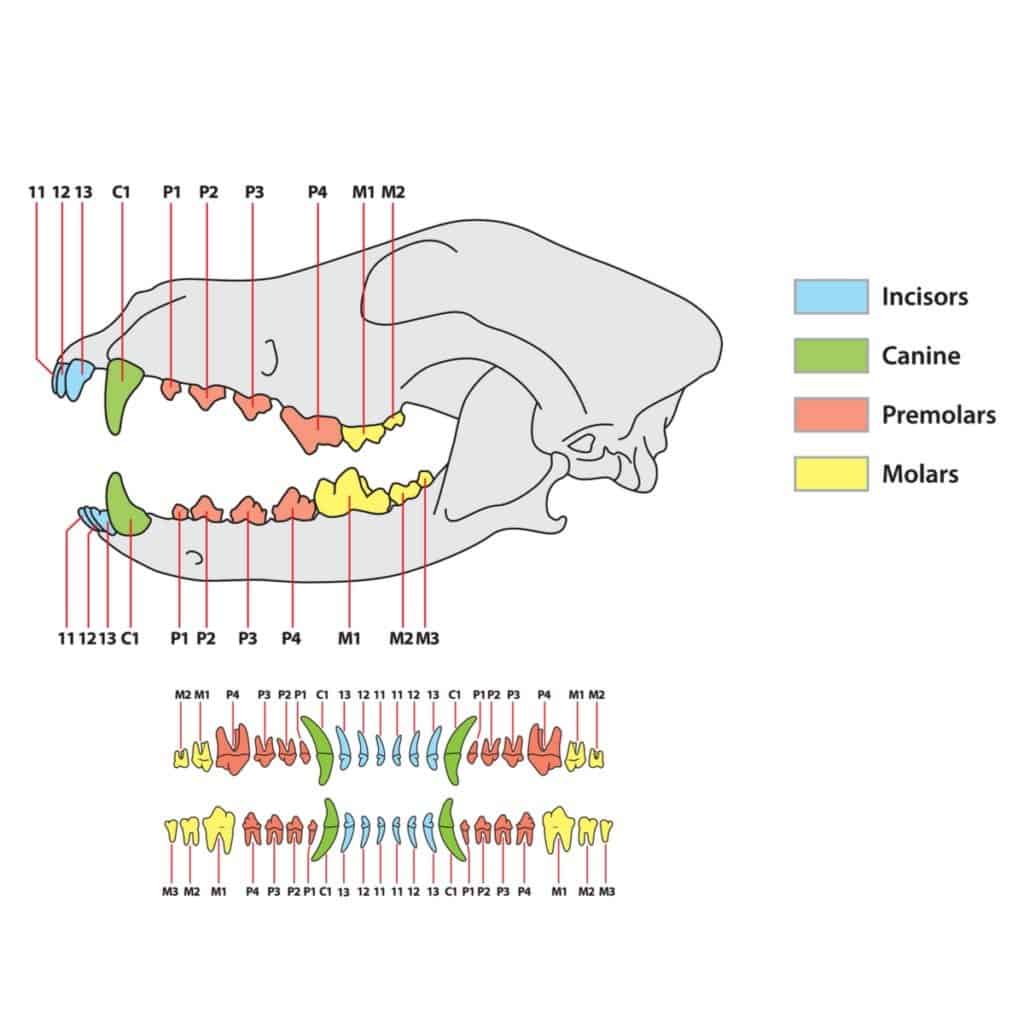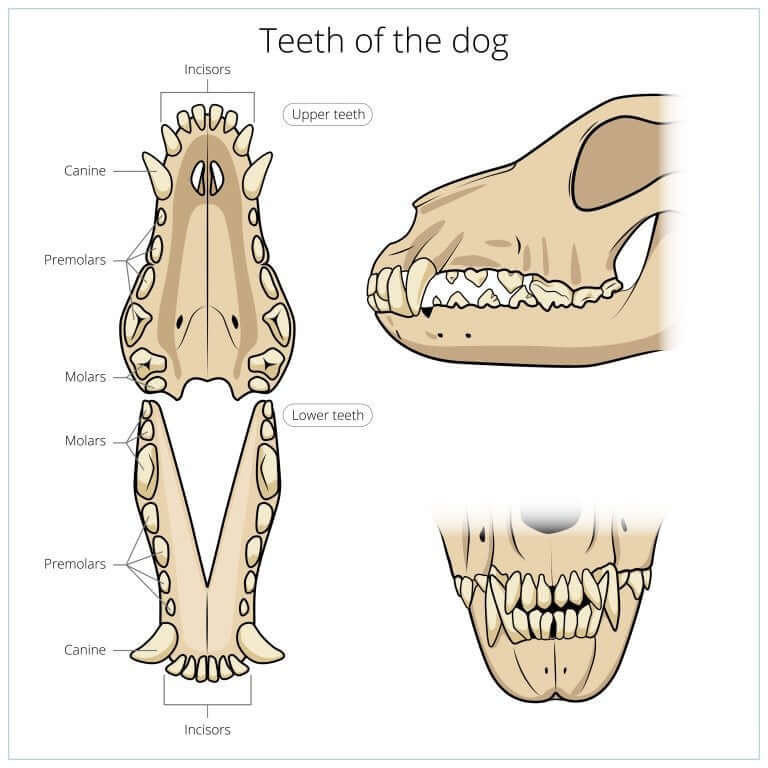
Dental Anatomy and Development Dental Disorders Merck Manuals Professional Edition
In mammalian oral anatomy, the canine teeth, also called cuspids, dog teeth, eye teeth, vampire teeth, or vampire fangs, are the relatively long, pointed teeth.In the context of the upper jaw, they are also known as fangs.They can appear more flattened however, causing them to resemble incisors and leading them to be called incisiform.They developed and are used primarily for firmly holding.

Load Wiring Dog Tooth Diagram
Colored in orange on the canine dental chart, premolar teeth are of differing sizes but have a common sharp edge. Adult dogs have 16 premolar teeth; eight on the top and eight on the bottom.

Canine Dental Anatomy Chart Dog Teeth Jaw Poster
What are canine teeth used for? These unique teeth are vital for eating, speaking, and supporting the structure of your mouth. When teeth are lost or weakened, it can change or misalign your bite. According to the ACI Medical and Dental School, canines are vital in eating to tear and rip apart food when chewing.

Canine Dental Anatomy Dog's Teeth & Dental Health AnatomyStuff
4. Molars. Molars are large, wide teeth that are rectangular in shape. These posterior teeth are present behind the premolars. They are the farthest back teeth of all permanent teeth. Molars are the most widely used teeth by a dog. There are ten of these in total, four in the upper jaw and six in the lower jaw.

Load Wiring Dog Tooth Diagram
How many sets of teeth does a dog have. Dogs therefore have two sets of teeth, baby teeth (28), which will eventually fall out, and adult teeth (42). Different types of dog teeth. As you can see in the diagram above, there are different types of dog teeth. These different types of dog teeth include Incisors, Canine, Premolars, and Molars.

Dental Structure Anatomy of Dogs Safari Veterinary in League City, TX
An adult dog should have 42 teeth in total: that's 20 on top of their jaw and 22 on the bottom. Take a look at our dog dental chart above to see how all 42 teeth are arranged. Most dogs have the same number of teeth. However, they will have a different number of adult teeth compared to a puppy. Puppies will usually have a total of 28 teeth.

Longitudinal Section of a Canine Tooth within its Bony Socket (Alveolus). Diagram Quizlet
Canines: Canines are the longer teeth at the front of a dog's mouth. These teeth fall behind the incisors on a dog dental chart. They can help dogs scrape meat from bones and lock on to prey or toys. Most dogs have four canines: two on top and two on the bottom. Premolars: Premolars are sharp teeth located behind the canines. These teeth.

Carnassial Dog Teeth Chart Dog Choices
APEX OF TOOTH. The apex of the tooth is the part of the tooth that is embedded the deepest into the bone. It is the tip of the tooth opposite the crown. The apex is the location where the nerves and blood vessels enter the tooth. The apex is a point that is commonly infected in a tooth causing an "apical abscess".

Dog Teeth Everything You Need To Know IMP WORLD
Canines are the long and pointed teeth found towards the front of your dog's mouth, behind the incisors on the dog dental chart. These teeth are used for tearing food such as meat apart. They are also used to lock on to an item a dog may have in its mouth, such as a bone or chew toy. Dogs grow four canine teeth, two on both the bottom and.

Canine Dental Chart Digital Etsy
The dog teeth anatomy is a highly specialized structure compared to the ruminants. You will find four different types of teeth in a dog - Incisor, canine, premolar, and molar. The number of dog teeth also vary (generally 42) in the different breed. Here, I will show you the anatomical facts of dog teeth with a labeled diagram.

canine teeth
The function of these teeth is to grab and tear. If your dog is fighting with another dog or is playing a game of fetch with you, then the canines are used to bite the ball or the other dog. Deciduous teeth include four 4 canines and 12 incisors. Premolars. These are the wide, flat, and pointed teeth that are situated behind the canines.

Canine classification. (A) Class I canine with the maxillary canine... Download Scientific Diagram
Most dogs have 28 deciduous teeth and 42 permanent teeth. The deciduous teeth begin to erupt at 3 to 5 weeks of age, while permanent teeth usually begin to appear at around 4 to 5 months. All permanent teeth are present by the time the dog reaches 7 months of age ( See table: Canine Adult Dentition ).

A Dog's Digestive System How Does it Work? My Animals
Understanding the Canine Dental Chart. Types of Dog Teeth. Dogs have four kinds of teeth: molars, premolars, canines, and incisors. Each one plays a unique role in your dog's dental well-being. Molars. Found all the way in the back of your dog's mouth, molars break apart hard foods and chews such as kibble, rawhide, and dog biscuits.

Explaining Dogs Dog Teeth Diagram Glamorous Dogs
arrow_drop_down. Educational Images arrow_drop_up. Anatomy of a tooth. "Four-handed" dentistry. Dental cleaning sequence. Hand scaling root surfaces. Subgingival curettage. Using compressed air. Injecting perioceuticals.

Dentistry and Oral Surgery Practical Skills Online Course Cornell University College of
The first view of the dog teeth diagram is a clear indication of their carnivorous nature. Almost every teeth with the teeth diagram plays a unique role in tearing and eating of flesh. The Sans Souci Dental team explains the use of sharp canine teeth. When a dog develops properly without any dental problem, they are expected to have a total of.

Dentistry and Oral Surgery Practical Skills Online Course Cornell University College of
Dog Teeth Diagram. The dog teeth chart pictured here shows the layout of the four specific teeth groupings in a dog's mouth. A dog's teeth anatomy is described with the first letter indicating the type of tooth and the number following indicating its position in the dog's mouth. Veterinarians use this method of describing the teeth for creating a detailed medical history in your dog's medical.